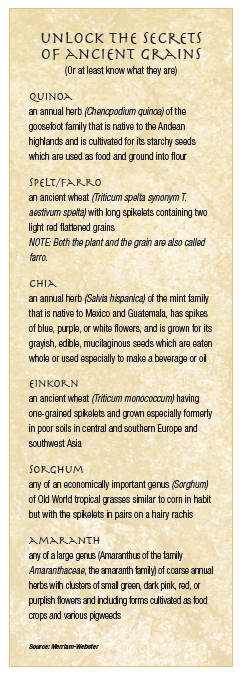
A Beneficial Union
As recently as May of 2016, The Plate, a blog published by www.nationalgeographic.com, reported about a national survey which found that 84 percent of Americans throw away food based on the sell by date stamped on packages. Yet, ancient — a word partly defined as having the qualities of age or long existence — is the latest movement in consumer food trends in regard to grains. But just like the best buy, sell by, or expiration date on packaged food doesn’t necessarily sound the alarm to clear out the pantries, neither does the ‘ancient’ in ancient grains, seeing as the meaning is much more regal for the latter.
In terms of consumable food, a term like ancient grain immediately piques curiosity and subtly demands respect, indicating that this ingredient has been around for quite some time. Ultimately, an ancient grain is one that has been largely unchanged over the last several hundred years, according to www.wholegrainscouncil.org. And similar to how kale, spinach, and collard greens enjoyed a superfood status when the family of dark, leafy greens was being highlighted as a new trend, ancient grains also has its standout culinary celebrities.
As reported by www.readersdigest.com, these seven grains could be the next quinoa: indian rice grass, spelt/farro, teff, fonio, millet, and Khorasan (kamut). However, honorable mentions we may be a little more familiar with that are also considered to be ancient grains include oats; chia seeds; black barley; blue corn; red, black, and wild rice; einkorn; sorghum; amaranth, and buckwheat. Additionally, along with spelt/farro, and teff, some of these “old” favorites are the most popular to bake with including oats, chia, buckwheat, and barley. Nonetheless, many sources agree that any ancient grain can be ground and used in baking as an alternate to regular flour.
 Due to the heavy influence of the Millennial generation, Americans have an increased interest in what they are consuming. And according to www.todaysdietician.com, ancient grains represent a return to a simpler, wholesome way of eating. Additionally, the digital resource reports several reasons for the rise in popularity of ancient grains, including their higher level of protein than durum wheat; their richness in vitamins, minerals, and phytochemicals; they offer a high supplement of fiber; and some are gluten-free — an important factor in today’s culture of dietary restrictions.
Due to the heavy influence of the Millennial generation, Americans have an increased interest in what they are consuming. And according to www.todaysdietician.com, ancient grains represent a return to a simpler, wholesome way of eating. Additionally, the digital resource reports several reasons for the rise in popularity of ancient grains, including their higher level of protein than durum wheat; their richness in vitamins, minerals, and phytochemicals; they offer a high supplement of fiber; and some are gluten-free — an important factor in today’s culture of dietary restrictions.
Furthermore, because less use of pesticides and fertilizers are necessary for the growth and maintenance of ancient grain crops, which also require less irrigation than wheat, there is a decreased carbon footprint regarding their cultivation, making them ecofriendly crops.
Nevertheless, America’s growing love for ancient grains touches more audiences than health enthusiasts and conservationists; they play an increasingly large role in the production of pastry and confection as well. Victoria Burghi, pastry chef, PreGel International Training Centers – FL believes ancient grains will have a place in pastry for quite some time because of the increasing need for gluten-free desserts. “Many of these grains have a dual function; not only will they be used as an alternative to other gluten-free flours, but since celiac disease has become more and more common, so will these grains,” Burghi explains. Of the vegan and vegetarian culinary audience, Burghi believes ancient grains flourish in this area as well, saying “Most of these grains are highly nutritious, providing essential amino acids for vegetarians, so I see a broad use of these in vegetarian and vegan baking,” Burghi concludes.
With 68 percent of respondents citing ancient grains as a “hot trend” in the National Restaurant Association’s chef survey, it’s no wonder chefs are looking for increasing ways to add them into their recipes for baked goods. A variety of breads have long incorporated the use of ancient grains into loaves of temptation, but the menu list is expanding to include cakes, cookies, tarts, brownies, donuts, cheesecake, frosting, jams, and more.
Of this transition from savory to sweet, Corporate Pastry Chef Sean Pera, PreGel International Training Centers – NC states “I think applications for ancient grains in pastry or desserts can range from items such as rice pudding made with a client grain like sorghum seeds or amaranth; they are extremely versatile in breads and would work well in cookie doughs and cake batters, but given the addition of fat and sugar I don’t know how healthy they would actually be.”
Kitty Broihier, MS, RD, LD, owner of NutriComm Inc Food and Nutrition Communications echoes a similar sentiment to Pera’s on
www.todaysdietician.com in regard to the augmentation of health via added sugars and fats. She states, “The health halo around ancient grains may lead folks to think that anything containing them has got to be nutritious, which, of course, is not always the case. Label reading is still important,” she concludes.
Editor’s note: See our article on nutritional labels on page 57
Despite an increased or moderate caloric intake, Americans have developed a curiously adventurous palate with an enthusiasm to explore the inclusion of ancient grains in a variety of their favorite foods. Undoubtedly, the future of ancient grains in pastry and confections is on the rise with no signs of faltering. Based on the number of ancient grain dessert recipe books in circulation and the American consumer’s increasing desire for new and good-for-you-foods, these nutritious bits of goodness will continue to add a wealth of flavor, texture, and overall nutritional value to original recipes, skyrocketing the reputation of ancient grains from dormant to desirable.
Lastly, from a business perspective, the consumer market’s willingness to pay more for what they deem higher quality products and ingredients, such as ancient grains, is an added value for patisserie owners who are considering the addition of ancient grains to their menus. Not only is it a means for menu expansion, but an avenue for increased profit margins based on a current trend with definite potential to become a culinary staple.
